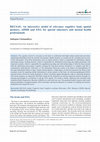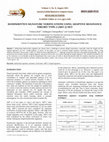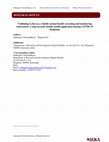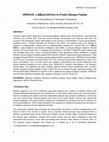Papers by Subhagata Chattopadhyay

Deleted Journal, Apr 19, 2024
Clinical decision support systems (CDSS) are gaining popularity in disease screening and grading ... more Clinical decision support systems (CDSS) are gaining popularity in disease screening and grading in the current era of digital healthcare. This paper attempts to model how a computer learns to grade an infectious disease (ID), e.g., typhoid fever using the machine learning (ML)-based approach mimicking how a novice doctor learns to diagnose a case with the help of senior doctors. To achieve the goal, ten virtual junior clinicians are developed using ten machine learning classifiers (MLC)-based CDSS, which are then trained with "weighted" [0,1] sign symptoms and the corresponding "labeled" grade of synthetic typhoid fever cases (N = 198). Weights and labels are assigned by ten senior clinicians providing their rich clinical knowledge base. The performance of each VJC is then measured in terms of their diagnostic accuracy, precision, recall, and F-score. Results show that random forest (RF, i.e., VJC9) and decision tree (DT, i.e., VJC4)-based CDSS can grade with an average of 87% accuracy, which is even higher than human clinicians' accuracy. The reason behind RF and DT's appreciable performance is that clinicians use tree-search-based methods with probabilistic "yes" and "no" logic to learn the disease patterns alike the working principles of DT and RF for diagnosing and grading any ID. Apart from modeling, the paper provides insight into how to select the right machine learning classifier (MLC) algorithm in the field of ID diagnosis. It also throws light on various hardships and challenges with MLC-based CDSS implementations in the real-world scenario.

Artificial intelligence evolution, Jan 25, 2024
Cardiovascular diseases (CVD) are a global threat of high morbidity and mortality. Myocardial inf... more Cardiovascular diseases (CVD) are a global threat of high morbidity and mortality. Myocardial infarction (MI) due to coronary vessel malfunctions is one of the leading causes of mortality due to CVD. Interestingly, all CVD patients do not develop MI, and vice versa. Clinically, thus, it is a gray area. Therefore, an appropriate MI risk scoring (MIRS) tool could be useful to identify the high-risk (HR) population suffering from CVD. This research paper presents a hybrid machine learning (ML) model (MLMI) to identify MI risk where a) clustering of the CVD population with the help of the Gaussian mixture model (GMM) is used to identify the HR and not high-risk (NHR) groups, b) feature engineering of the members in both the HR and NHR populations using regression method that estimates the coefficient of determination (R 2) to explore significant features to create the model by c) leveraging the R 2 values > 0.7 as the key features of the input dataset to a d) Feed-forward neural network (FFNN) for scoring the risk on a set of synthetic patient data, created by three experienced medical doctors. The myocardial infarction risk scores (MIRS) would assist users in prioritizing the patients needing monitoring and treatment. Finally, the MIRS values are validated by another group of three medical doctors to curb the research bias. The sensitivity, specificity, precision, F 1 scores, and accuracy of the MLMI model are computed to measure its efficiency. With limited input data, the proposed model shows an average accuracy, and precision of 77.33% each, while sensitivity and F 1 score are 100% and 88%, respectively.

Diagnostics and Therapeutics, Jan 2, 2024
The cognitive load (CL) increases as the brain is confronted with high-volume audiovisual and oth... more The cognitive load (CL) increases as the brain is confronted with high-volume audiovisual and other multimodal information from the external environment. Spatial memory is a broad term for recording and recovery of this information. It has three dimensions, such as sensory memory, which is responsible for information capture and preprocessing, working memory, which is responsible for information processing and output generation, and long-term memory, which is responsible for registration/encoding and retrieval/decoding of what has been learned after the information processing. Cognitive training for long-term memory formation is a complex task that is conducted by analysing the "relevance" of the information. Relevance refers to the degree of meaningfulness of the input information based on logic, beliefs and perceptions. A high degree of relevance promotes the firing of the reentrant circuit for capturing similar information to create memory in the brain. An electroencephalogram (EEG) measures brain activities by using electrodes to deliver waveform signals through the scalp at a particular duration. This article proposes an interactive RECSAE model for the formation of relevant long-term memory through CL training and attempts to corroborate it with the EEG signals. The model is finally explained and correlated with Attention Deficit Hyperactive Disorder (ADHD) as a real-world use case. The proposed model is generic and would help psychologists, neurophysiologists, EEG researchers and special educators to evaluate CL training and memory dysfunctions by using EEG waves.

Indian Journal of Mental Health
Background: Empty Nest Syndrome (ENS) is a complex grief state, observed in the affected parents ... more Background: Empty Nest Syndrome (ENS) is a complex grief state, observed in the affected parents when their children leave home. Studies show ENS may progress to clinical-grade depression and anxiety if left uncared for. Methodology: In this double-blind case-control cross-sectional study, 80 subjects are recruited by a panel of psychologists and psychiatrists. Subjects are divided into two equal groups-case (with ENS symptoms) and control (without symptoms). Three instruments are applied-a) ENS interpretation by the psychologists based on the symptoms, b) Lyfas smartphone-based biomedical application to capture the cardiovascular optical biomarkers (COB) from the index finger non-invasively with the help of arterial photoplethysmography technique, and c) Hamilton's depression scales (HAM-D), which psychiatrists have used to check the mental health of the subjects. The COB (e.g., SD1/SD2, LF/HF, HRVScore, and ENERGY) and a set of physical parameters (e.g., Body mass index or BMI, Heart rate or HR, Systolic blood pressure or SBP, Diastolic blood pressure or DBP, Glycosylated hemoglobin or HbA1c, Cholesterol, Triglyceride, Thyroid-stimulating hormone or TSH, Estradiol or E2, and Testosterone or TST) consist the independent variables, while ENS scores interpreted by the psychologists and HAM-D scores interpreted by the psychiatrists are the dependent variables. Spearman's rank correlation and Bland Altman's reliability tests are performed to mine the significant independent variables and reliability of Lyfas ENS (LENS) application. Results: The study observes that SD1/SD2, LF/HF, HRVScore, ENERGY, DBP, BMI, HR, HbA1c, TSH, and Estradiol have significant roles in ENS. Bland Altman's reliability measure shows that LENS (novel instrument under trial) has a high agreement of 92.85% and 93.86%, respectively with ENS scoring done by senior psychologists (champion instrument1) and HAM-D grading performed by psychiatrists (champion instrument2). Conclusions: LENS can be used as a clinical-graded pocket application for screening and monitoring ENS.

Medinformatics, 2024
Clinical decision support systems (CDSS) are gaining popularity in disease screening and grading ... more Clinical decision support systems (CDSS) are gaining popularity in disease screening and grading in the current era of digital healthcare. This paper attempts to model how a computer learns to grade an infectious disease (ID), e.g., typhoid fever using the machine learning (ML)-based approach mimicking how a novice doctor learns to diagnose a case with the help of senior doctors. To achieve the goal, ten virtual junior clinicians are developed using ten machine learning classifiers (MLC)-based CDSS, which are then trained with "weighted" [0,1] sign symptoms and the corresponding "labeled" grade of synthetic typhoid fever cases (N = 198). Weights and labels are assigned by ten senior clinicians providing their rich clinical knowledge base. The performance of each VJC is then measured in terms of their diagnostic accuracy, precision, recall, and F-score. Results show that random forest (RF, i.e., VJC9) and decision tree (DT, i.e., VJC4)-based CDSS can grade with an average of 87% accuracy, which is even higher than human clinicians' accuracy. The reason behind RF and DT's appreciable performance is that clinicians use tree-search-based methods with probabilistic "yes" and "no" logic to learn the disease patterns alike the working principles of DT and RF for diagnosing and grading any ID. Apart from modeling, the paper provides insight into how to select the right machine learning classifier (MLC) algorithm in the field of ID diagnosis. It also throws light on various hardships and challenges with MLC-based CDSS implementations in the real-world scenario.

Journal of Global Research in Computer Sciences, Sep 10, 2012
Authorizing handwritten signature has always been a challenge to prevent illegal transactions, es... more Authorizing handwritten signature has always been a challenge to prevent illegal transactions, especially when the forged and the original signatures are very "similar-looking" in nature. In this paper, we aim to automate forged signature verification process, offline, using Adaptive Resonance Theory type-2 (ART-2), which has been implemented in "C" language using both sequential and parallel programming. The said network has been trained with the original signature and tested with twelve very similar-looking but forged signatures. The mismatch threshold is set as 5%; however, it is set flexible as per the requirement from case-to-case. In order to obtain the desired result, the vigilance parameter (ρ) and the cluster size (m) has been tuned by carefully conducted parametric studies. The accuracy of the ART-2 net has been computed as almost 100% with ρ = 0.97 and m = 20.

Series of cardiology research, 2023
Heart rate variability (HRV) is defined as the momentary variation in the end heart rate (EHR) es... more Heart rate variability (HRV) is defined as the momentary variation in the end heart rate (EHR) estimated at various intervals (time domains), such as from 2 min (ultra-short HRV) to 24 h (long HRV) intervals. The R peak interval (RRI) between two consecutive beats called momentary heart rate (MHR) provides insight into the impending cardiovascular risk and not the EHR. The autonomic nervous system (ANS) is in charge of maintaining physiological homeostasis by keeping the MHR and in turn the EHR within the normal range of 60–100 bpm. ANS has two components – the sympathetic nervous system (SNS) and the parasympathetic nervous system (PNS). The former increases HR (reduces RRI) while the latter reduces it. Therefore, the RR time-domain-HRV-data (THD) provides better insight into overall health than the EHR. Six types of THDs, e.g., mean-HR, mean-RR, SDNN, SDHR, RMSSD, and pNN50 are discussed in this article.
Increasing cigarette smoking has been observed in males as a sign of being macho and manly. Howev... more Increasing cigarette smoking has been observed in males as a sign of being macho and manly. However, the reality is contrastingly unfortunate as tobacco smoking has an adverse influence on male sexual health causing mild-to-severe grades of impotence or erectile dysfunction (ED) with associated psychological issues, together these are termed here as the tobacco-penis syndrome (TPS). This brief review details the epidemiology, pathophysiology, and molecular basis of ED in smokers. It also discusses the consequential psychological aspects beyond the TPS. The article aims to generate awareness among men with elaborated scientific pieces of evidence in a concise manner.
Journal of Medical Imaging and Health Informatics, Mar 1, 2013

Medical research archives, 2022
COVID-19 has disturbed mental health to a great extent. Lockdowns, re-infections in fully vaccina... more COVID-19 has disturbed mental health to a great extent. Lockdowns, re-infections in fully vaccinated people, frequent mutations of the virus, working from home, shutting of school colleges, contradictory information flying in the air, and so on are some serious predisposing factors in deteriorating the mental health. The Indian Govt. has granted the telemedicine model of healthcare in the country. Mobile health (mHealth) adds to it effectively and Lyfas is such a smartphone-based instrument that works using the principle of arterial photoplethysmography and photochromatography. It captures short (120 sec) heart rate variability (HRV) and the allied optical biomarkers that surrogate for the cardiovascular autonomic modulation, which is influenced by mental health issues. The study aims to validate Lyfas optical biomarkers (SD1/SD2, LF/HF, pNN50, and HRVscores) and a set of physical parameters e.g., age, HR, BPsystolic and diastolic, and serum cortisol in addressing the mental health state. A total of RTPCR positive 1130 adults (Male 541, Female 589) within the age group of 27-68 yrs. participated in the study. Till the participants became RTPCR negative (average time of 14 days), the Depression-Anxiety-Stress Screening-21 (DASS-21) and Covid Screening Scale (CSS)-based monitoring is done once daily to note the distress levels, and Lyfas tests are taken thrice daily simultaneously. The average of all scores constructs the experimental data. Internal consistency (Cronbach's α), normality test (Shapiro Wilkis test), and Spearman's correlations (ρ) and their respective statistical significance (p<0.05, CI: 95%) are computed. The study concludes that Lyfas biomarkers show strong correlations with that of the DASS-21 and CSS scores. Physical parameters are also corroborative to the result.

Research Square (Research Square), Apr 13, 2022
Background Anger phenotyping in perimenopausal women is a complex task due to multifactor involve... more Background Anger phenotyping in perimenopausal women is a complex task due to multifactor involvement. Anger sets sympathetic overdrive and affects the sympathovagal balance. Lyfas is a novel smartphone-based non-invasive optical biomarker instrument. It captures short Heart rate variability (HRV) and its correlated optical biomarkers using the method of arterial photoplethysmography and assesses the sympathovagal balance. Aims This study is designed to mine the signi cant optical biomarkers (SDNN, RMSSD, pNN50, SD1/SD2, and LF/HF) and physical parameters (Age, HR, BMI, systolic and diastolic BP, estradiol, TSH, HbA1c, and cortisol) to construct a novel hybrid Lyfas Anger Screening Instrument (LASI) and then validated against the well-acclaimed Clinical Anger Scale (CAS) in anger phenotyping. Settings and Design: It is a case-control study with a total of 415 perimenopausal women (case: 205 and healthy control: 210). Methods and material: Lyfas tests were performed thrice/day for 2 weeks and their biomarkers' scores are captured. During the same period, they have also recorded the anger episodes as per the CAS scoresheet. Statistical analysis used: LASI is constructed using Spearman's correlation (ρ and p-values) and validated against the CAS instrument with Bland Altman's inter-rater reliability assessment by noting the strength of agreement. Results BMI, BP, TSH, and HbA1c shows a signi cant positive correlation with anger. LASI scores high for recall (95%), speci city (75%), precision (92%), accuracy (71%), Youden's index (J-statistic, 74%), and fscore (74%). Conclusion LASI is quali ed to be used in the clinical setup in anger screening and monitoring.
Journal of nanotechnology in diagnosis and treatment, Oct 31, 2021
Duchene Muscular Dystrophy (DMD) is a progressive neuromuscular disorder affecting male children ... more Duchene Muscular Dystrophy (DMD) is a progressive neuromuscular disorder affecting male children of a career mother, as seen in more than 70% of cases. It is an X-linked recessive disease that affects 1 in 3600-6000 live male births. As the child grows, muscles are progressively wasted and degenerated in the body. As time passes, it also involves intercostal and heart muscles leading to cardiorespiratory failure and death. Using a smartphone-based application namely, Lyfas that uses the principles of the optical sensor, arterial photoplethysmography, and photochromatography, this report focuses on capturing digital cardiovascular biomarkers at the backdrop of DMD and understanding the physiological aspect of the disorder and its progression, especially the risk of the involvement of cardiac muscles.

Research Square (Research Square), Aug 30, 2022
Diagnostic healthcare has ambiguities due to the literal expression of symptoms, e.g., more, less... more Diagnostic healthcare has ambiguities due to the literal expression of symptoms, e.g., more, less, moderate, severe, and so on. Acute abdomen, associated with pain, vomiting, and fever of various grades, are commonly encountered in the surgical emergency department. Peritonitis is one of the commonest acute abdomens. It needs immediate medical attention as it can be life-threatening. Developing nations lack experienced clinicians and high-end investigation facilities, especially in the rural setup. Thus, referral of such cases to higher facilities is the mainstay procedure. A timely referral is a challenge. This paper has explained an intelligent referral system (IRS) by developing a fuzzy decision system (FDS) of Mamdani-type. Three symptoms-pain, vomiting, and fever, each having three grades, e.g., poor, average, and good are the inputs to the FDS, while the grade of peritonitis is the output as a low, medium, and high grade based on the fuzzy rule base obtained from an expert clinician. The e cacy of the FDS is tested and validated in three arbitrary cases. Introduction: Clinical healthcare has its ambiguities, especially in the usage of several literal terms, such as more, less, adequate, poor, well, good, worse, bad, better, and many more while stating the health conditions. These terms create a wide and inde nite search space for both the providers
bioRxiv (Cold Spring Harbor Laboratory), Aug 11, 2022

Medical research archives, 2022
COVID-19 has disturbed mental health to a great extent. Lockdowns, re-infections in fully vaccina... more COVID-19 has disturbed mental health to a great extent. Lockdowns, re-infections in fully vaccinated people, frequent mutations of the virus, working from home, shutting of school colleges, contradictory information flying in the air, and so on are some serious predisposing factors in deteriorating the mental health. The Indian Govt. has granted the telemedicine model of healthcare in the country. Mobile health (mHealth) adds to it effectively and Lyfas is such a smartphone-based instrument that works using the principle of arterial photoplethysmography and photochromatography. It captures short (120 sec) heart rate variability (HRV) and the allied optical biomarkers that surrogate for the cardiovascular autonomic modulation, which is influenced by mental health issues. The study aims to validate Lyfas optical biomarkers (SD1/SD2, LF/HF, pNN50, and HRVscores) and a set of physical parameters e.g., age, HR, BPsystolic and diastolic, and serum cortisol in addressing the mental health state. A total of RTPCR positive 1130 adults (Male 541, Female 589) within the age group of 27-68 yrs. participated in the study. Till the participants became RTPCR negative (average time of 14 days), the Depression-Anxiety-Stress Screening-21 (DASS-21) and Covid Screening Scale (CSS)-based monitoring is done once daily to note the distress levels, and Lyfas tests are taken thrice daily simultaneously. The average of all scores constructs the experimental data. Internal consistency (Cronbach's α), normality test (Shapiro Wilkis test), and Spearman's correlations (ρ) and their respective statistical significance (p<0.05, CI: 95%) are computed. The study concludes that Lyfas biomarkers show strong correlations with that of the DASS-21 and CSS scores. Physical parameters are also corroborative to the result.

Transactions on Machine Learning and Artificial Intelligence, Mar 24, 2022
Background: This paper demonstrates a framework for testing of efficacy (reliability and validity... more Background: This paper demonstrates a framework for testing of efficacy (reliability and validity) of a novel instrument against a gold-standard instrument. Lyfas is a novel, non-wearable, non-invasive, and economic optical biomarker instrument that runs on android smartphones. By capturing the Pulse Rate (PR) and Pulse Rate Variability (PRV) from the index finger capillary using photoplethysmography, it measures the Cardiovascular Autonomic Modulation (CvAM). The Polar H10 sensor is a gold-standard electrical biofeedback instrument that comes with a wearable chest belt and is a relatively costly device. It captures the Heart Rate (HR) and Heart Rate Variability (HRV) that surrogates Cardiac Autonomic Modulation (CAM). Objective: To showcase the statistical framework in mining the efficacy of Lyfas as a biofeedback instrument by comparing it with that of the Polar H10 instrument following a ‘6Minute Walk Test’. Method: Using Lyfas and Polar H10 HR sensor, PR and HR were captured from 567 subjects(n=567, 312 healthy adult males, and 255 females, respectively). The data was checked for the (a) internal consistency (Cronbach’s alpha), (b) its distribution (Q-Q plots), (c) descriptive statistics (box plots), (d) Root Mean Square difference between the HR and PR, (e) reliability (Bland-Altman Reliability Test), and (f) correlations using (i) Pearson’s inter-class correlations (r), and (ii) Linear regressions (R2). Results: The efficacy of Lyfas as a biofeedback instrument has finally been computed by averaging the mean scores of BART (93.53%), ‘r’ (86.96%), and R2 (87.58%) for the sample and found to be 87.27%. Conclusion: Lyfas can also be used as a biofeedback instrument.
Indian International Conference on Artificial Intelligence, 2005

The cognitive load (CL) is mounting as the brain is flooded with more and more visual and auditor... more The cognitive load (CL) is mounting as the brain is flooded with more and more visual and auditory cues. Spatial memory is a broad term for recording and recovery of information. It has three dimensions, such as sensory memory (responsible for information capture and preprocessing), working memory (responsible for information processing), and long-term memory (responsible for registration/encoding and retrieval/decoding of what is learned after information processing). Cognitive training for long-term memory creation is a complex task through the analysis of the relevance of the information. Electroencephalogram (EEG) is an index of brain activities. Using electrodes, it captures the electrical signals of the brain at a timestamp through the scalp. The objective of the article is to model relevance-to-long-term memory creation through CL training and attempt to map with the EEG signals. The proposed model would help psychology, neurophysiology, and EEG researchers to evaluate CL training and memory dysfunctions with the help of EEG waves. It is further explained in the light of attention deficit hyperactive disorder (ADHD).

arXiv (Cornell University), Apr 29, 2021
Clinicians make routine diagnosis by scrutinizing patients' medical signs and symptoms, a skill p... more Clinicians make routine diagnosis by scrutinizing patients' medical signs and symptoms, a skill popularly referred to as "Clinical Eye". This skill evolves through trial-and-error and improves with time. The success of the therapeutic regime relies largely on the accuracy of interpretation of such sign-symptoms, analyzing which a clinician assesses the severity of the illness. The present study is an attempt to propose a complementary medical front by mathematically modeling the "Clinical Eye" of a VIRtual DOCtor, using Statistical and Machine Intelligence tools (SMI), to analyze Dengue epidemic infected patients (100 case studies with 11 weighted sign-symptoms). The SMI in VIRDOCD reads medical data and translates these into a vector comprising Multiple Linear Regression (MLR) coefficients to predict infection severity grades of dengue patients that clone the clinician's experience-based assessment. Risk managed through ANOVA, the dengue severity grade prediction accuracy from VIRDOCD is found higher (ca 75%) than conventional clinical practice (ca 71.4%, mean accuracy profile assessed by a team of 10 senior consultants). Free of human errors and capable of deciphering even minute differences from almost identical symptoms (to the Clinical Eye), VIRDOCD is uniquely individualized in its decisionmaking ability. The algorithm has been validated against Random Forest classification (RF, ca 63%), another regression-based classifier similar to MLR that can be trained through supervised learning. We find that MLR-based VIRDOCD is superior to RF in predicting the grade of Dengue morbidity. VIRDOCD can be further extended to analyze other epidemic infections, such as COVID-19.

International journal of performability engineering, Apr 1, 2006
Performance testing of an algorithm is necessary to ascertain its applicability in real data and ... more Performance testing of an algorithm is necessary to ascertain its applicability in real data and to evolve software. Clustering of a data set could be either fuzzy (having vague boundaries among the clusters) or crisp (having welldefined fixed boundaries) in nature. The present work is focused on the performance measure of some similarity-based fuzzy clustering algorithms, where three methods and each method having three different approaches are developed. In the first method, cluster centers are decided based on the minimum of entropy (probability) values of different data points [10]. In the second method, cluster centers are selected based on the maximum of total similarity values of data points and in the third method, a ratio of dissimilarity to similarity is considered to determine the cluster centers. Performances of these methods and approaches are compared on three standard data sets, such as IRIS, WINES, and OLITOS. Experimental results show that entropy-based method is able to generate better quality clusters but at the cost of little more computations. Finally, the best sets of clusters are mapped to 2-D using a self-organizing map (SOM) for visualization.











Uploads
Papers by Subhagata Chattopadhyay